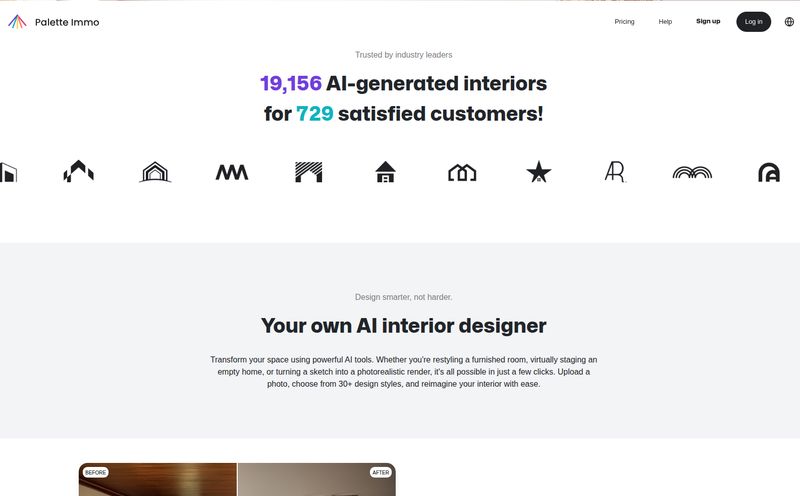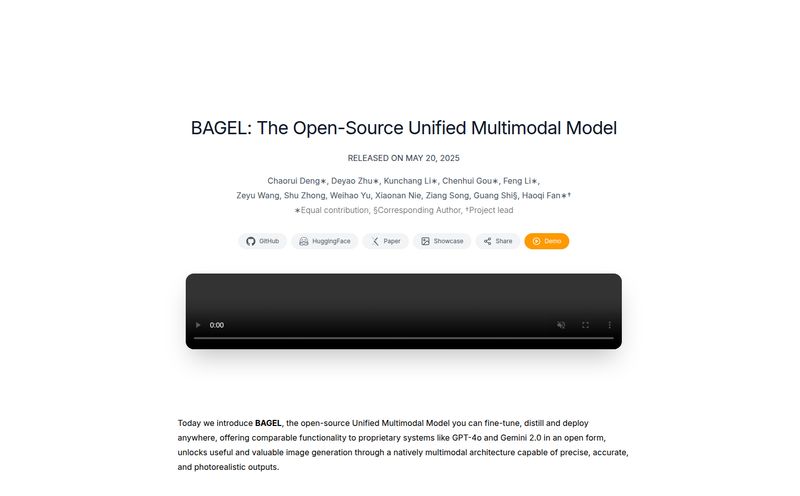I’ve been in the SEO and digital marketing world for a long, long time. I’ve seen trends come and go, from the keyword stuffing dark ages to the rise of social proof. But the one thing that’s consistently been a tough nut to crack is marketing for highly visual, service-based industries. Like interior design or real estate. How do you sell a vision? How do you get a client to see what you see in their head, without sinking dozens of hours into a mock-up they might not even like?
We’ve all been there. You spend ages crafting the perfect mood board, pulling samples, and sketching layouts. Then you present it, and the client says, “Hmm, I’m not sure about that shade of blue.” Back to the drawing board. It’s a part of the job, sure, but it’s a time sink.
Enter the AI wave. We’ve seen it write copy, generate images of cats in space, and now, it’s coming for our living rooms. I've been watching tools like Spatia Studio pop up, and my professional curiosity—and a healthy dose of skepticism—kicked in. They claim to generate designs from a simple photo in seconds. Seconds! So, I decided to take a proper look. Is this just another shiny tech toy, or is it a legitimate tool that can actually change how design and real estate professionals work?
So What Exactly Is Spatia Studio?
At its core, Spatia Studio is an AI-powered design platform. But that’s a bit of a dry description. Let’s try a better analogy. Imagine you have a junior designer who is impossibly fast, has an encyclopedic knowledge of design trends, and works for coffee (or in this case, credits). That’s kind of what Spatia Studio is. You feed it an image of a space—a drab living room, an empty new build, a cluttered office—and within moments, it spits out a fully reimagined version of that space.
It’s not just about slapping on a new coat of digital paint. It’s changing furniture, adding decor, altering layouts, and presenting a tangible, visual concept. This is the kind of tech that aims to bridge the gap between a client's vague idea and a concrete proposal, and do it fast.
The Features That Actually Matter
A platform is only as good as its tools. I’ve seen too many apps that promise the world and deliver a glorified Microsoft Paint. So what’s under the hood with Spatia Studio?
From a Napkin Sketch to a Stunning Reality
One of the coolest things I saw was the sketch-to-image feature. This is huge. Every designer has had that flash of inspiration that gets scribbled onto a notepad or the back of a receipt. Normally, turning that rough sketch into something presentable takes time and software skills. Here, the AI interprets your lines and shapes, and generates a polished, photorealistic image. It’s a fantastic way to bring an initial concept to life without the heavy lifting.
The Magic of Reimagination and Virtual Staging
This is the bread and butter, especially for my colleagues in real estate. We all know an empty house is a hard sell. It feels cold, and buyers struggle to visualize its potential. Traditional staging is expensive and a logistical headache. Virtual staging has been around for a bit, but often looks clunky or fake. Spatia Studio’s approach feels different. By using a real photo of the room, the AI-generated staging feels more grounded in the actual space. You can take a picture of a client’s dated family room and instantly show them a modern, minimalist version or a cozy, rustic alternative. This isn't just a gimmick; it's a powerful sales and engagement tool.

Visit Spatia Studio
More Than Just Pretty Pictures: Editing and Product Sourcing
Here’s what separates a useful tool from a novelty. AI can generate a beautiful room, but what if the client hates that one specific armchair? Spatia lets you edit the generated images, tweaking details to get closer to the perfect design. But the real clincher for me is the product sourcing. The AI can identify the items in its own design and help you find similar, real-world products to purchase. This closes the loop. It moves from “what if” to “here’s how.” It’s one thing to show a client a cool picture; it’s another to say, “And you can buy that exact lamp right here.” That’s where you drive real revenue.
Let's Talk Money: The Spatia Studio Pricing Plans
Okay, let's get down to brass tacks. Is this going to break the bank? Honestly, the pricing structure seems pretty reasonable, especially for the value it offers. They have a tiered system, which I always appreciate.
| Plan | Price | Key Details |
|---|---|---|
| Basic | $0 / month | 30 credits per month. Perfect for just trying it out and seeing if it fits your workflow. |
| Standard | $29 / month | 300 credits, 100 GB of asset storage, and access to all the features. This feels like the sweet spot for freelancers and small agencies. |
| Enterprise | Contact for Quote | This is for the big leagues. Custom models, API access to integrate with your own tools, enhanced security. |
The free 'Basic' plan is a no-brainer. 30 credits is enough to get a feel for the platform and run a few test projects. For less than the cost of a few fancy coffees a month, the 'Standard' plan gives you a serious amount of creative firepower.
The Not-So-Rosy Side and Where It Falls Short
No tool is perfect, and it would be dishonest to pretend otherwise. My experience tells me to always look for the catch. With AI design tools like Spatia Studio, there are a few things to keep in mind.
First, there's the GIGO principle: Garbage In, Garbage Out. The quality of your AI-generated design is heavily dependent on the quality of your source image. A blurry, poorly lit photo taken on a ten-year-old phone is not going to yield magazine-worthy results. You need clear, well-lit photos to give the AI a fighting chance.
Second, let’s talk about creative control. Some designers might feel that relying on an AI for initial concepts is a crutch. And they have a point. If you let the AI do all the thinking, you risk creating generic, trend-chasing designs. I don’t see this as a replacement for a designer's unique vision. I see it as a brainstorming partner. It can break you out of a creative rut or show you a possibility you hadn't considered, but the final design should always have your expert human touch.
So Who Is This Actually For?
After playing around and analyzing its features, I've got a pretty clear picture of who gets the most out of Spatia Studio.
- Interior Designers: A fantastic tool for rapid ideation. Instead of spending a day on one detailed mock-up, you can generate five different concepts in thirty minutes. It’s about working smarter, not harder.
- Real Estate Agents & Stagers: This is a game-changer for marketing properties. Virtual staging is faster and cheaper, and showing a potential buyer what their future home could look like is an incredibly powerful sales tactic.
- Property Developers & Managers: Trying to pre-lease a unit that's still under construction? Or show investors the potential of a renovation? This is your tool. It makes the future tangible.
- Ambitious DIYers: While it's built for pros, a homeowner who is serious about their renovation project could definitely get their money's worth out of the Standard plan to visualize ideas before knocking down walls.
Frequently Asked Questions About Spatia Studio
Can I use my own products in Spatia Studio?
While the platform has a powerful product sourcing feature to find real-world items, its primary function isn't to insert specific SKUs into a design. It's more about generating a style and then finding products that match that style.
How many designs can I make with 30 credits?
Typically, one design generation consumes a certain number of credits. The exact number can vary, but 30 credits should be enough to let you experiment with several different rooms or styles to see if you like the results.
Is Spatia Studio difficult to learn?
From what I've seen, teh interface is designed to be intuitive. The whole point is speed and efficiency, so the learning curve appears to be quite gentle. If you can upload a photo, you can use the basic features.
Will this AI tool replace my interior design job?
Short answer: No. It's a tool, like Photoshop or AutoCAD. It augments your skills, it doesn't replace them. A client still needs your expertise in space planning, project management, and understanding their unique needs. This just makes the first step of the process faster.
What kind of image quality do I need to upload for the best results?
Think clear, bright, and straightforward. A high-resolution photo taken in good, natural light from a straight-on angle will always give the AI the best information to work with, leading to more accurate and appealing designs.
Final Thoughts: A Gimmick or a Game Changer?
So, what’s my final verdict? Spatia Studio is far from a gimmick. It’s a genuinely useful, well-thought-out tool that addresses a real pain point in the design and real estate industries. The ability to generate and iterate on visual concepts instantly is incredibly powerful.
It won't replace the skill and soul of a great designer. It won't negotiate with contractors for you. But it will save you time, impress your clients, and potentially close more deals. It’s an accelerator for your creativity. In an industry where time is money and vision is everything, that’s a pretty compelling proposition. If you’re in this field, kicking the tires on the free plan is, in my professional opinion, a very smart move.



